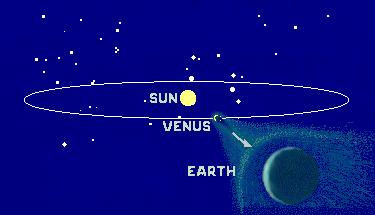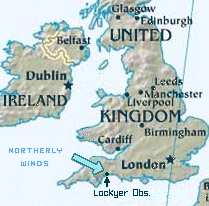|
* * *
The following bio on D.R. Barber is from the 1963 Perspective journal.
Formerly superintendent of the Norman Lockyer Observatory of the University of
Exeter. Born in 1901, was educated at St. John's Hospital and Heles schools, Exeter;
graduated with honours in physics (B.Sc.), London University, 1925. Lecturer in
physics at Seale-Hayne Agricultural College, Newton Abbot 1930 to 1936, where he
did biological research work for the Ministry of Agriculture, Fisheries and Food.
Became Assistant Astronomer at Norman Lockyer Observatory, Sidmouth in 1936.
Worked as Martin Kellogg Fellow in Astronomy at the Lick Observatory of the
University of California, 1940-1941. At Kodak Research Laboratories, Harrow,
1941-1945. Returned to the Norman Lockyer Observatory in 1945 as Chief Assistant,
was appointed Superintendent in 1956, retiring in 1961. Is a fellow of the Institutes
of Physics, of the Royal Astronomy Society and of the Royal Photographic Society.
Donald Barber died in August 2000. His obituary is printed in the Blackwell Synergy® online journal:
Astronomy & Geophysics - The Journal of the Royal Astronomical Society.
References
(1) Barber, D. R., "Invasion by Washing Water," Perspective,
Vol. 5, No. 4, pp.201-208, (1963) Focal Press, London, New York. The article was reprinted in the
November 1964 issue of Analog Science Fact - Science Fiction.,Ed. John W.
Campbell, Jr.
(2) Barry, John,
The site of the origin of the 1918 influenza pandemic and its public
health implications, Journal of Translational Medicine,
2, 3, (2004).
(3) Kolata, Gina,
Flu, The Story of the Great Influenza Pandemic of 1918
and the Search for the Virus That Caused It,
Simon & Schuster, Touchstone, New York, (1999).
(4) Velikovsky, Immanuel,
Worlds in Collision, The Macmillan Company, pp. 183-187 (1950).
(Macmillan sold their rights to Doubleday & Company, Inc. in 1950 and there
is also a hard cover first edition of Worlds in Collision by
the latter publisher in 1950.)
(5) Shu, Frank, The Physical Universe, An Introduction to Astronomy,
p. 532, University Science Books, Mill Valley, CA (1982).
Recommended sites and further reading
Flu from Venus? Time, 21 Feb 1944, page 90. [Excerpts from original
article.] - Professor Louis Backman of Uppsala University, Stockholm,
suggested that it was entirely possible that organisms causing recent flu
epidemics had come from Venus, Jupiter or Mars. ... Laboratory workers know
that that bacteria and other living cells can survive the near-absolute-zero
temperature of interplanetary space. ... University of California professor
Charles B. Lipman once claimed that he had found living bacteria locked in
meteorites millions of years old. ...No one else has confirmed Lipman's
finding, and scientists have remained skeptical. ... Backman believes it
very unlikely that life originated on the earth; he thinks it more properly
started in the more favorable atmospheres containg methane and ammonia gases
which surround planets such as Jupiter, Venus and Mars. From them, he says,
living organisms may have been transported to the earth by meteorites or
by the propulsive power of the sun's rays. [Added 29 Oct 2005. Thanks
to Google's daily alert service. Search phrase: venus influenza.]
Influenza Pandemic -
AndyPryke.com. Good historical overview of influenza pandemics and
influenza-like pandemics from 412 BC to present. [Added 4 Sep 2005.]
Planetary exploration in the time of
astrobiology: Protecting against biological contamination - John D. Rummel,
PNAS, 2001, 98, 2128-2131 (2001). [Added 24 Jan 2012. This link replaces one to an
earlier one on the same topic.]
An Influence of the Heliogeophysical
Conditions on Influenza Diseases - E.S. Babayev. Abstract:For purposes of studying of possible
influence of the solar and geomagnetic activity on influenza diseases and epidemic, the data
covering the time period of 1976-2004 is studied for the Absheron Peninsula area including the
capital city Baku (the Republic of Azerbaijan) with several millions of inhabitants. Period,
duration, intensity and seasonal behavior of the influenza epidemic, tendency of its beginning
within a solar cycle are determined. Investigations reveal that influenza epidemic usually
begins 2-3 years before and / or 2-3 years after the 11-years sunspot cycle maximum. We suppose
that solar activity affects the influenza epidemic mainly through geomagnetic activity (magnetic
storms). The comparative analysis of years of high solar activity and both periods of originating
of epidemics and pandemics on the base of antigenic formulas of influenza viruses described with
the help of characters of structure of a virus (hemagglutinin and neuraminidase) has revealed
definite regularity in the circulation of influenza infections. Forecast method for prophylactic
measures is developed for considered region. Obtained results are interpreted and compared with
similar ones.
[Added 2 December 2003. Edited] [Replaced with a follow-on article on 14 Aug 2016.]
Madness - Gerald N. Callahan, Emerging Infectious Diseases September 2002.
Solar wind blows some of Earth's atmosphere into space - Science@NASA -
December 8 1998. (Added 11 August 2002.)
Earth weaves its own invisible cloak Polar fountains fill magnetosphere with ions. -
NASA Marshall Space Flight Center - space sciences features - December 9, 1997.
(Added 11 August 2002.)
Dust Storm on Planet Earth - Astronomy Picture of the Day - 2000 March 3.
(Shows 26 February 2000 picture of Saharan dust blowing out over the Atlantic.)
Credit: SeaWiFS Project, NASA- http://oceancolor.gsfc.nasa.gov/SeaWiFS/".
Influenza B Virus Outbreak on a Cruise Ship -- Northern Europe, 2000
[Outbreak occurred in the June 23-July 5, 2000 timeframe in the Baltic. Passengers
were primarily from the United States.]
"Although results of rapid viral testing for influenza A and B
viruses were negative, immunofluorescence staining and viral culture results
implicated influenza B as the cause of the outbreak." - CDC MMWR March 02,
2001 / 50(08);137-140.
1976: Fear of a great plague - Paul Mickle - The Trentonian
Diseases
from Space by Fred Hoyle and Chandra Wickramasinghe, J.M. Dent
& Sons,
London, 1979.
|
|

